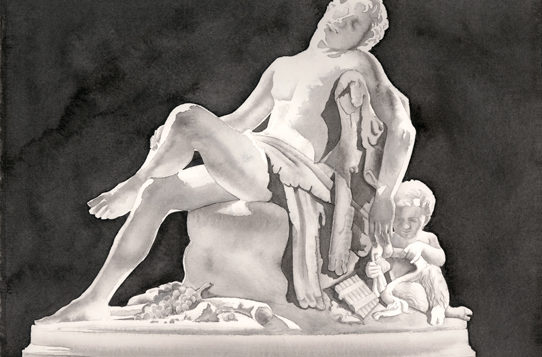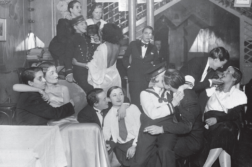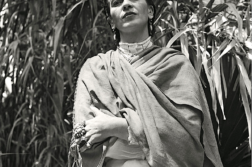HARRIET HOSMER (1830–1908) was a lesbian sculptor who emigrated from the United States to Rome at an early age to become part of an expatriate community of writers and artists, including a circle of prominent “independent women.” She worked in marble, and the quality of her surviving sculptures is extraordinary. The operative word is surviving: much of Hosmer’s work has been lost or destroyed, preserved in sketches and descriptions in dusty catalogs but otherwise forgotten.
Enter Patricia Cronin, who came across Hosmer’s work while searching for inspiration for a marble sculpture that she was planning to create. Eight years later, Cronin has brought her tribute to Harriet Hosmer to fruition in the form of a book of paintings and an exhibit at the Elizabeth A. Sackler Center for Feminist Art at the Brooklyn Museum of Art. The 62 black-and-white watercolors, twenty of which were on display in New York, are featured in a catalogue raisonné entitled Harriet Hosmer: Lost and Found (Charta Books, 2009), and represent Cronin’s attempt to capture on a flat surface the lost or in some cases unrealized sculptures of her 19th-century counterpart.
 Indeed the two artists have a number of things in common: both were born in Massachusetts; both studied sculpture in the U.S.; and both ended up spending time in Rome to ply their trade. Hosmer moved to Europe in 1852 to expand her career and find a more tolerant atmosphere for a life as an independent woman and a lesbian. Her gaze is a lesbian gaze, as lesbian artist Tee Corinne has pointed out, focusing on female desire. Cronin’s interpretations create spaces where women can interact with female subjects in erotic and non-erotic contexts. Her style of art is an expression of tangible pleasure that deliberately builds tension by stressing the uncertain character of sexual feelings and spiritual connection across generations.
Indeed the two artists have a number of things in common: both were born in Massachusetts; both studied sculpture in the U.S.; and both ended up spending time in Rome to ply their trade. Hosmer moved to Europe in 1852 to expand her career and find a more tolerant atmosphere for a life as an independent woman and a lesbian. Her gaze is a lesbian gaze, as lesbian artist Tee Corinne has pointed out, focusing on female desire. Cronin’s interpretations create spaces where women can interact with female subjects in erotic and non-erotic contexts. Her style of art is an expression of tangible pleasure that deliberately builds tension by stressing the uncertain character of sexual feelings and spiritual connection across generations.
Last summer I had the pleasure of viewing the exhibit in Brooklyn, and also of conversing with the artist about Harriet Hosmer and her homage to this nearly forgotten artist. As for the marble sculpture that Cronin was planning back in 2000 when she discovered Hosmer’s work, she ended up producing the exquisitely beautiful piece, Memorial to a Marriage, that appears on the cover of this issue.







